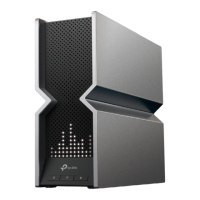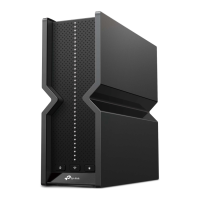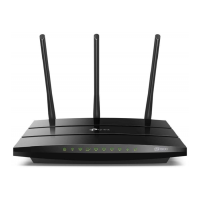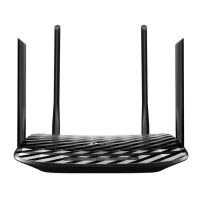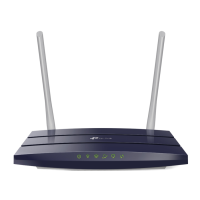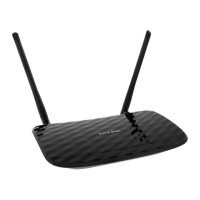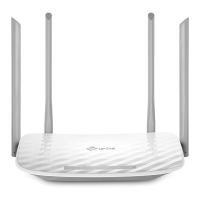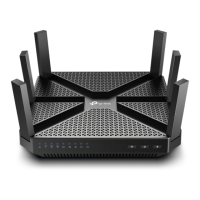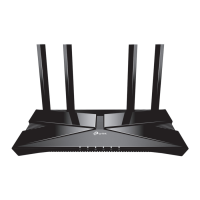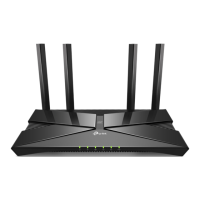Do you have a question about the TP-Link Archer BE9300 and is the answer not in the manual?
Step-by-step instructions for physically connecting the router to the modem and power source.
Guides users through an automated process for setting up the internet connection via the router's wizard.
Instructions for configuring the internet connection using the TP-Link Tether mobile application.
Provides detailed steps for manually configuring various internet connection types like Dynamic IP, PPPoE, etc.
Steps to configure the router to function as an access point, extending an existing wired network wirelessly.
Configuration of wireless network names (SSIDs), passwords, security options, and advanced wireless parameters.
Setting up restrictions on internet access for family members, including content filtering and time limits.
Steps to integrate another TP-Link router into the network as a satellite device for expanded Wi-Fi coverage.
Enabling SPI Firewall to protect the network from unauthorized traffic and cyber threats.
Configuring port forwarding rules to allow external access to internal services like web servers or game servers.
Setting up an OpenVPN server on the router to allow secure remote access to the home network.
Configuring a PPTP VPN server for remote access, offering ease of use but potentially lower security.
Setting up an L2TP/IPSec VPN server for secure remote access, providing better security than PPTP.
Configuring a WireGuard VPN server for fast, secure, and modern remote access to the home network.
Instructions for updating the router's firmware via auto-update, online check, or local file upload for improved functionality.
Backing up current router settings to a file and restoring them later, or resetting to factory defaults.
Changing the password used to access the router's web management interface for enhanced security.
Troubleshooting steps for recovering or resetting a forgotten wireless network password.
Solutions for forgotten web management passwords, including password recovery features and factory resets.
Troubleshooting steps for internet connectivity issues after configuration, including DNS and modem/router checks.
Steps to resolve issues with finding or connecting to the wireless network, covering adapter drivers and security key mismatches.
Step-by-step instructions for physically connecting the router to the modem and power source.
Guides users through an automated process for setting up the internet connection via the router's wizard.
Instructions for configuring the internet connection using the TP-Link Tether mobile application.
Provides detailed steps for manually configuring various internet connection types like Dynamic IP, PPPoE, etc.
Steps to configure the router to function as an access point, extending an existing wired network wirelessly.
Configuration of wireless network names (SSIDs), passwords, security options, and advanced wireless parameters.
Setting up restrictions on internet access for family members, including content filtering and time limits.
Steps to integrate another TP-Link router into the network as a satellite device for expanded Wi-Fi coverage.
Enabling SPI Firewall to protect the network from unauthorized traffic and cyber threats.
Configuring port forwarding rules to allow external access to internal services like web servers or game servers.
Setting up an OpenVPN server on the router to allow secure remote access to the home network.
Configuring a PPTP VPN server for remote access, offering ease of use but potentially lower security.
Setting up an L2TP/IPSec VPN server for secure remote access, providing better security than PPTP.
Configuring a WireGuard VPN server for fast, secure, and modern remote access to the home network.
Instructions for updating the router's firmware via auto-update, online check, or local file upload for improved functionality.
Backing up current router settings to a file and restoring them later, or resetting to factory defaults.
Changing the password used to access the router's web management interface for enhanced security.
Troubleshooting steps for recovering or resetting a forgotten wireless network password.
Solutions for forgotten web management passwords, including password recovery features and factory resets.
Troubleshooting steps for internet connectivity issues after configuration, including DNS and modem/router checks.
Steps to resolve issues with finding or connecting to the wireless network, covering adapter drivers and security key mismatches.
| Wi-Fi Standard | Wi-Fi 7 (802.11be) |
|---|---|
| Bands | Tri-band |
| Frequency Band | 2.4GHz, 5GHz, 6GHz |
| USB Ports | 1 x USB 3.0 |
| MU-MIMO | Yes |
| OFDMA | Yes |
| EasyMesh Compatible | Yes |
| Total Wi-Fi Speed | 9300 Mbps |
| Antenna | 8 external antennas |
| Processor | Quad-core CPU |
| Security | WPA3 |

